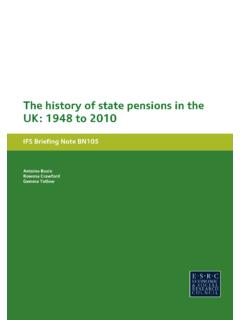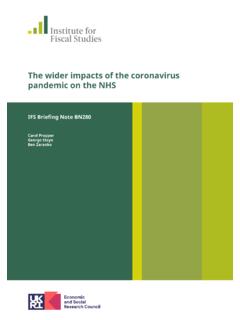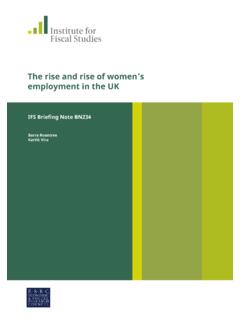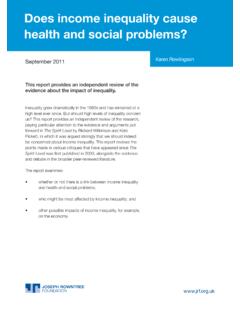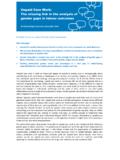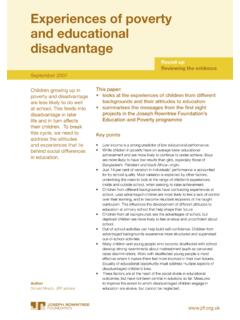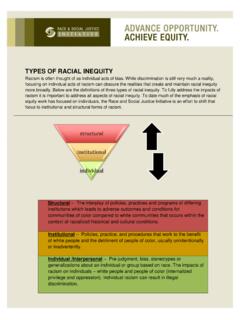Transcription of Living standards, poverty and inequality in the UK: 2020
1 Pascale Bourquin Robert Joyce Agnes Norris Keiller Living standards, poverty and inequality in the UK: 2020 Living standards, poverty and inequality in the UK: 2020 Pascale Bourquin Robert Joyce Agnes Norris Keiller Copy-edited by Judith Payne The Institute for Fiscal Studies Published by The Institute for Fiscal Studies 7 Ridgmount Street London WC1E 7AE Tel: +44 (0) 20-7291 4800 Email: Website: Twitter: @TheIFS The Institute for Fiscal Studies, June 2020 ISBN 978-1-912805-87-7 Preface The Joseph Rowntree Foundation has supported this project as part of its programme of research and innovative development projects, which it hopes will be of value to policymakers, practitioners and service users (grant reference 1712001). The views expressed in this report are, however, those of the authors and not necessarily those of the Foundation. Neither are the views expressed necessarily those of the other individuals or institutions mentioned here, including the Institute for Fiscal Studies, which has no corporate view.
2 Co-funding from the ESRC-funded Centre for the Microeconomic Analysis of Public Policy at IFS (grant number ES/M010147/1) is also very gratefully acknowledged. Data from the Family Resources Survey were made available by the Department for Work and Pensions, which bears no responsibility for the interpretation of the data in this report. The Households Below Average Income data prior to 1994 95 were constructed from the Family Expenditure Survey. These data are available from the UK Data Service. The UK Household Longitudinal Study is an initiative funded by the Economic and Social Research Council and various government departments, with scientific leadership by the Institute for Social and Economic Research, University of Essex, and survey delivery by NatCen Social Research and Kantar Public. The research data are distributed by the UK Data Service. The authors would like to thank Mark Brereton, Paul Johnson, Peter Matejic and others at the Joseph Rowntree Foundation, and Neil Sorensen for their helpful comments.
3 Any errors and all views expressed are those of the authors. Contents Key findings 5 1. Introduction 7 2. Living standards and income inequality 9 Changes in household incomes in the UK 9 inequality 13 3. poverty 19 poverty trends 20 poverty among workless households 26 4. Conclusion 30 Appendix A. The Households Below Average Income (HBAI) methodology 31 Appendix B. Additional results 37 References 42 Key findings Institute for Fiscal Studies 5 Key findings The COVID-19 crisis hit at a time when income growth had already been extremely disappointing for some years. Median (middle) household income was essentially the same in 2018 19 (the latest data) as in 2015 16. This stalling itself came after only a short-lived recovery from the Great Recession. The combined effect had been a decade of unprecedented poor improvements in Living standards, with average income before housing costs having grown less than over any other 10-year period since records began in 1961.
4 The main culprit for the latest choking-off of real income growth had been a rise in inflation from 2016. This was partly due to the depreciation of sterling following the Brexit referendum. For people aged 60 or over, median income was 12% higher in 2018 19 than before the previous recession in 2007 08, while among the rest of the population it was only 3% higher. However, in recent years, income growth had stalled for old and young alike. Trends among low-income households had been worse still they had experienced five years of real income stagnation between 2013 14 and 2018 19. This was entirely due to falls in income from working-age benefits and tax credits, which offset growth in employment incomes. Working-age benefits were frozen in cash terms, so the rise in inflation from 2016 reduced their value in real terms by 5%. Overall relative poverty (using incomes measured after housing costs are deducted (AHC)) was 22% in 2018 19, and it has fluctuated little since the early 2000s.
5 For particular groups, though, we have seen more change. Relative poverty among working-age adults without children has fallen since 2011 12, while relative child poverty has increased by 3 percentage points the most sustained rise in relative child poverty since the early 1990s. Absolute AHC poverty was 20% in 2018 19 virtually unchanged over the last two years. The recent lack of progress in reducing absolute poverty is disappointing: it only fell by percentage points between 2010 11 and 2018 19 whereas reductions over an equivalent period in previous decades were around 5 6 percentage points on average. Workers whose livelihoods look most at risk during the COVID-19 crisis already tended to have relatively low incomes, and were relatively likely to be in poverty , prior to the onset of the crisis. Employees working in shut-down sectors , such as hospitality, were already almost twice as likely to be in poverty as other employees, and poverty rates were higher still for self-employed people working in these sectors.
6 Cleaners and hairdressers stand out as groups with higher poverty rates than other workers who are unlikely to be able to work from home. Living standards, poverty and inequality in the UK: 2020 6 Institute for Fiscal Studies In 2018 19, only 12% of non-pensioners lived in households with no one in paid work, down by a third from 18% in 1994 95. This progress is highly likely to be undermined by the COVID-19 pandemic. Despite temporary increases in benefits announced in response to the pandemic, the benefits system in 2020 provides less support to out-of-work households than in 2011. Average benefit entitlement among workless households is 10% lower in 2020 21 than it would have been without any policy changes since 2011, and among workless households with children it is 12% lower. These cuts in generosity are mainly due to the benefits freeze and the introduction of universal credit; without the temporary increases, they would have been 15% and 16% respectively.
7 Introduction Institute for Fiscal Studies 7 1. Introduction This report examines how Living standards most commonly measured by households incomes were changing in the UK up to approximately the eve of the current COVID-19 crisis, using the latest official household income data covering years up to 2018 19. We particularly focus on how this differed for different groups, and what this meant for poverty and inequality . It gives us a comprehensive account of where we stood before the current crisis, including for groups who we now know have subsequently had their economic lives turned upside down. The analysis in this report is chiefly based on data from two UK household surveys. The first is the Family Resources Survey (FRS), a survey of around 20,000 households a year, which contains detailed information on different sources of household incomes. We use household income variables derived from the FRS by the UK government s Department for Work and Pensions (DWP).
8 These measures of incomes underlie the DWP s annual statistics on the distribution of income, known as Households Below Average Income (HBAI). The FRS/HBAI data are available for the years from 1994 95 to 2018 19. They are supplemented by HBAI data derived from the Family Expenditure Survey (FES) for the years from 1961 to 1993 94. In addition, we draw on data from Understanding Society: the UK Household Longitudinal Study (UKHLS) to hone in on what was happening to poverty amongst groups who are likely to be particularly vulnerable to the COVID-19 pandemic in terms of potential employment losses or reductions in earnings. UKHLS is a household panel survey that contains detailed information on household income and individual characteristics, such as the industries that individuals work in and the occupations that they undertake. The economic implications of the COVID-19 pandemic will mean a reduction in household incomes as workers lose their jobs, earnings fall, and plummeting share prices and interest rates lead to lower incomes from savings and investments.
9 Unfortunately, post-COVID data from the headline FRS/HBAI data on which official income statistics are based will not be available for some time. The focus of this report is somewhat different: using the FRS/HBAI data that we do have up to approximately the eve of the current crisis to understand in detail where we were as it hit, and how this reflects the direction of travel and of policy over the years since the last recession in the late 2000s. The intention is that this provides important context for what we are seeing now. The main outcomes of interest in this report are measures of household income. We use the measure of income that is used in the HBAI statistics. Further details regarding the methodology of HBAI can be found in Appendix A, but a few key points are worth summarising here: We conduct our analysis at the individual level, meaning that we look at poverty , inequality and differences in Living standards between individuals, not between households.
10 However, income is measured at the household level, as the total income of all individuals Living in the same household. A household for these purposes is not the same as a family, which is defined simply as a single adult or couple and any dependent children they have. For instance, young adults Living together (other than as Living standards, poverty and inequality in the UK: 2020 8 Institute for Fiscal Studies a couple) would be classified as being in the same household but not in the same family. Income is rescaled ( equivalised ) to consider the fact that households of different sizes and compositions have different needs. Income is measured after deducting income tax, employee and self-employed National Insurance contributions, and council tax, and it includes income from state benefits and tax credits. Income is measured both before housing costs have been deducted (BHC) and after they have been deducted (AHC). All cash figures are presented in 2018 19 prices and all income growth rates are given after accounting for inflation.
